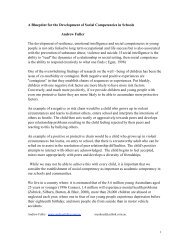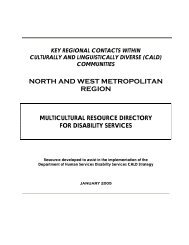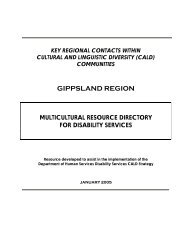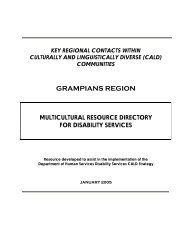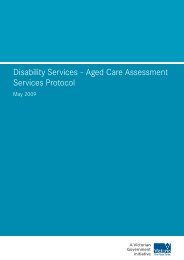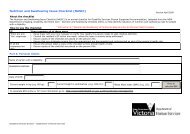Positive Behaviour Support - Department of Human Services - Vic ...
Positive Behaviour Support - Department of Human Services - Vic ...
Positive Behaviour Support - Department of Human Services - Vic ...
You also want an ePaper? Increase the reach of your titles
YUMPU automatically turns print PDFs into web optimized ePapers that Google loves.
<strong>Positive</strong> behaviour support: Getting it right from the start - Facilitators reference manual 83<br />
Strategy Example <strong>of</strong> how it may be used<br />
Encourage relaxation 1. Acknowledge that the person is upset.<br />
2. Instruct the person to calm down.<br />
3. Instruct the person in activities that promote<br />
relaxation (Soles <strong>of</strong> the feet, deep breathing, music,<br />
etc).<br />
4. Leave the situation, if necessary, where they can<br />
remain undisturbed.<br />
5. When they arrive, try to help them to get<br />
comfortable and relaxed. Encourage the person<br />
throughout.<br />
Do something completely unexpected<br />
Response is usually only momentary but allows<br />
time to evade.<br />
The surprise will wear <strong>of</strong>f if it is used repeatedly.<br />
Sing a song loudly.<br />
Inter-positioning Paul, who weighs about 90kg, rushes towards a staff<br />
member with his hands in the air. The staff member<br />
positions herself behind a table and uses ‘active<br />
listening’.<br />
Example immediate response strategy plan<br />
Barry runs from the kitchen table towards the front<br />
door <strong>of</strong> his house which fronts a busy street. Staff<br />
position themselves between him and the door and<br />
speak loudly enough to distract his focus.<br />
These strategies are designed to defuse or de-escalate a potentially serious episode<br />
<strong>of</strong> the behaviour when the warning signs are apparent, or to manage a serious episode<br />
when it occurs. Reactive strategies are NOT designed to bring about long-term<br />
behaviour change.<br />
The diagram below is commonly known as the stress or anger cycle. It represents a<br />
series <strong>of</strong> phases that can be observed as people escalate in the degree <strong>of</strong> aggressive or<br />
agitated behaviour. Following is a list <strong>of</strong> the known activities and situations that trigger<br />
the person’s behaviour, and also those behaviours or warning signs that can at times be<br />
seen prior to a serious episode occurring. This list aims to provide people supporting the<br />
person with an observation strategy that enables them to intervene as early as possible in<br />
the behaviour cycle.<br />
Phase 1. Phase 2. Phase 3. Phase 4. Phase 5<br />
Triggering event Escalation<br />
(warning signs)<br />
Crisis Recovery Post crisis<br />
depression



